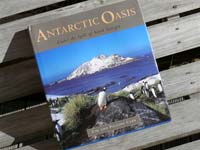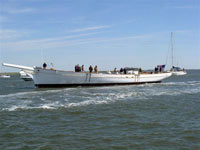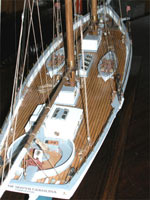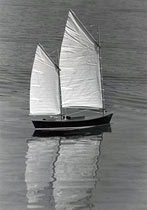Turks & Caicos Islands sailing, a beautiful book, a new schooner launched and a model cross-masted cat

(click thumbnails for larger views) |
 |
In the Turks and Caicos Islands at a beach on Middle Island they periodically race model yachts in the shallow surf. This first photograph (above) is almost like a painting and shows the skippers running behind the sterns of their non-radio controlled craft, perhaps to keep them on course, perhaps even to ensure that they don’t suddenly veer off and sail away to another island. There are a few regattas every year and I guess it pays to be fit ! Here is your Geography lesson (in case you have never heard of these islands) They are 575 miles South-East of Miami and they cover 193 square miles of the Atlantic ocean. By the way. the boats are carved from large branches of the gum-elemi tree and each sloop has it’s weatherboard in order to stabilize it in the ocean water. A simple form of model yachting at little expense and as I have always been saying, yet another form of model sailboating
 |
 |
Someone I met many many years ago in Plymouth, Montserrat in the Caribbean Leewards island group had a weird cross-eyed cat that I clearly remember, but I have to admit that I had never heard of a catamaran with a rig consisting of a mast on or closely situated to each hull. That was until Auckland Ancient Mariner, Alexander Bartlett produced this RC model version. Multihull followers may well be aware of the concept. Alex, known for his fine ketches and schooners wanted to build something `different’ and after talking to well known kiwi yacht designer, Jim Young he decided to base the model on one of Jim’s `Typhoon’ hull designs, then go non-conventional with regard to mast placement ie a mast on each hull.
Hull construction was of 3mm marine ply on 4mm ply frames, the length overall 1,160mm with a beam of 570mm. Alex went for a mast height of 900mm which although it looked `right’ I tend to favour slightly taller masts which with added sail area would possibly improve the `get up and go’ of the model. He made the masts and spars out of model aeroplane aerofoil shape aluminium.
The boat aptly named Duet which is a lovely name, however had one disadvantage noticed when the boat was first trialled, that being the windward sail tended to blanket the leeward one. Alex worked on correcting that but eventually re-rigged the model as a single-master and a better sailing model resulted.
 |

Photograph at left by Tim Carr |
Where Albatross and Dias died! To me there is always a touch of sadness when a boat of any kind sinks at sea or goes down completely or partially but permanently at her moorings, what is left of the vessel then a reminder of once proud days and later abandonment to tides that will eventually break her up. This wonderful sadness-evoking photograph by Tim Carr of Falmouth punt Curlew fame taken at Grytviken on South Georgia Island in the Antarctic, shows the rusting remains of the 1906 trawler Dias and the 1921 whale catcher Albatross. One of the very best books I have ever seen, and one of my most prized possessions is Tim and Pauline Carr-s book Antarctic Oasis published by Norton, the photograph usage courtesy of Tim and Pauline Carr, the authors. In my humble opinion, if you only bought one more book in your life this is it, for you owe it to yourself to read about and look at truly stunning and rare photographs of the wildlife and the majestic scenery of this still unspoilt part of the planet on which we live.
 |
 |
|
What an exciting model yacht Club ! I chanced upon the website of the Paderewski Model Yacht Club in Plainville, Connecticut, USA and remained riveted somewhat to it. Great scenic sailing water, some eight classes of boats from Footy’s up to the Canterbury J’s as they have in Christchurch, New Zealand and a well put together website that is both interesting and `exciting’ to say the least. Maybe a bigger story later, time will tell. but meanwhile have a look at both the Canterbury J paint job above, and the other photograph of a new Canterbury J boat on the lakeside. Membership of the club is made up of a group of model yachting enthusiasts who gather on Saturdays and Wednesdays, to sail during Spring, Summer and Fall and some really dedicated and `hardy’ souls also sail during the Winter whenever the pond is clear of ice.
`there is a very fine line
between hobby
and mental illness’
`Loopy’ Ludwig (who didn’t quite make it !)
Ron Rule, an Auckland Ancient Mariner model sailor, started off by drawing a triangle on a scrap of paper then this rather stunning little Footy-sized model (above left) resulted. It goes well enough too but it is too early to know how fast it may be. A few weeks after I had seen it, I received a release from Estrella Damm, the Spanish Brewery, advising that their red dart-like IMOCA Open 60 (seen above right) had won its first race on August 8th (The Artemis Challenge) run as part of Skandia Cowes Week. Each of seven boats were racing for a charity, Estrella Damm with a crew of seven for Africa Viva, a charity based in Barcelona working on development programmes in Western Africa. Now Ron’s Footy is not disimilar the Open 60 in appearance is it?
 |
 |
 |
 |
Andrew Charters of Meggett in South Carolina, USA has added a fisherman’s staysail to his favourite among all his schooners. Elizabeth Silsbee, the new sail seen above drawing well. This leads me to show you in the second photograph which he took, the new 150 ton, 140’ pilot schooner Spirit of South Carolina after she was launched. The boat has got such beautiful lines I keep hinting to Andrew that she would make a lovely RC model. The other two photographs show a fine display model already built of the boat, one Bill Baum of Brevard, North Carolina, the man who built the model, then the model itself. The South Carolina Maritime Heritage Foundation mission is to offer a unique educational platform for students, to encourage responsibility and teamwork, and other attributes to become future leaders.

`Don’t go to sea without money, for if the
ship were to go down you’d want to have
a monetary offering if only for the fish to
know that their dinner host was a man of
some wealth and generous to a fault’.
Aurelius BangBangdimus 1847-1899
(and please don’t say you haven’t heard of him!)
|
 |
 |
Steve Levesque, now First Officer of the Marine Modellers Club of New England and until the end of the last year, Commodore, is not only an excellent craftsman, but a most energetic and enthusiastic and prolific model builder. He is seen here with his ketch Jammon which is a John Storrow design, the boat also shown photographed under sail by Bill Richards in the second photograph. The club has no official home base or clubhouse and sails at a pond in Medway, Massachusetts about 25 miles west of Boston. Bill tells me that the club is about fifteen years old and was originally focused on member-built scale model RC boats, but the range of interests covered has now broadened to help compensate for declining membership.
Tobago Quickie
Sudden as an errant bug, wanderlust it gripped me,
and as I watched my life flow by, like a fish temptation nipped me.
My hull was clothed in barnacles,
auxilliary engine old and tired,
decking worn and sails all torn, I so long retired.
So it would seem I could only dream, put away the travel cases,
leave the seas to other dreamers lured by distant places.
Then I heard the call of the pond, (those islands aint so far),
batteries are charged the sun is out and the schooner is in the car.
Out on the water the fun kicked in
and we shot down a wave and were flying,
but when I got home, yelled “BEEN TO TOBAGO”,
the wife instantly knew I was lying!
Mark Steele
|

